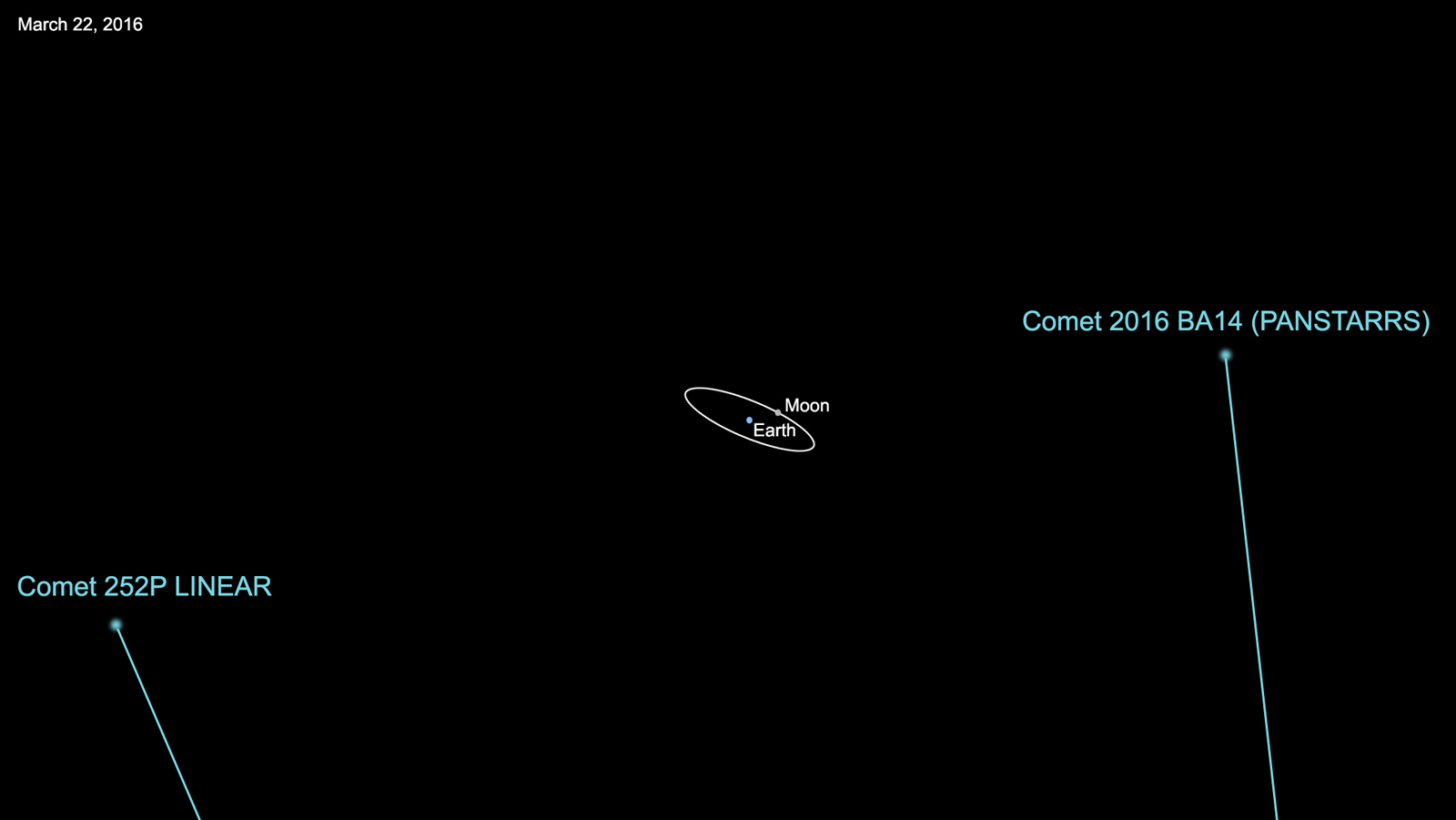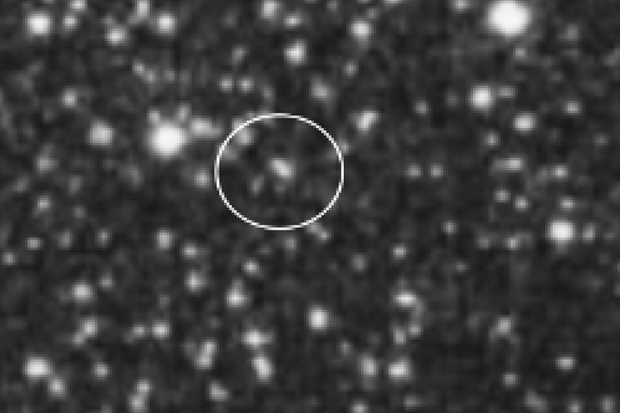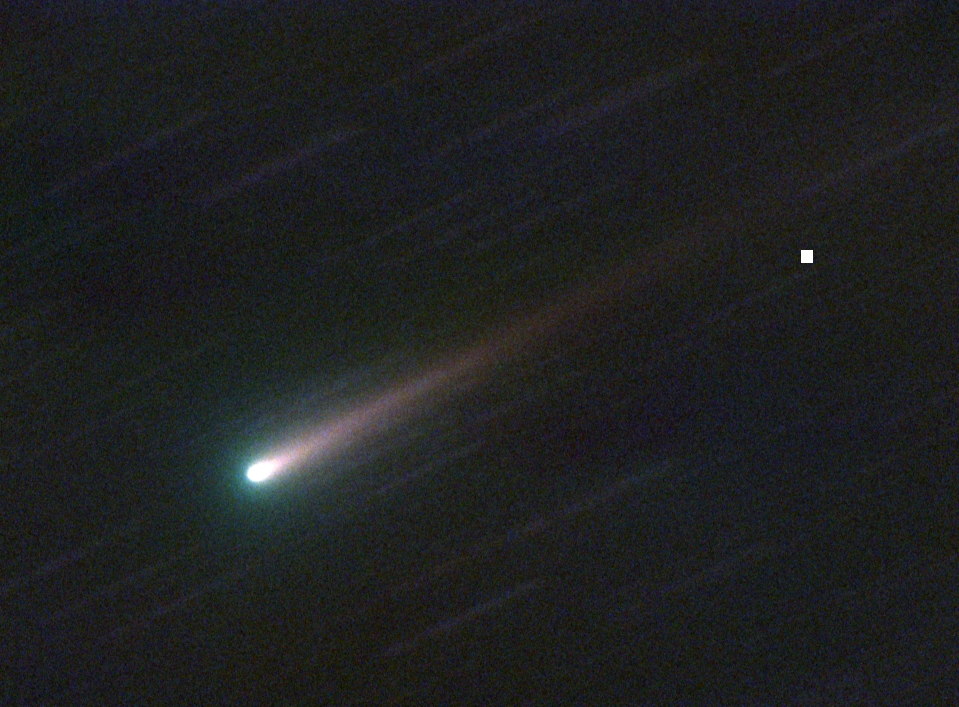
A comet will zoom past Earth Tuesday morning (March 22) in a close encounter of historic proportions.
Comet P/2016 BA14, which you can see in this video of the object and its orbit, will come within 2.2 million miles (3.5 million kilometers) of the planet at about 10:30 a.m. EDT (1430 GMT) Tuesday. Only two other comets have come closer to Earth throughout recorded history — Comet D/1770 L1 (Lexell) in 1770 and C/1983 H1 (IRAS-Araki-Alcock) in 1983, NASA officials said.
Comet Lexell's flyby brought it within 1.4 million miles, or 2.2 million km, of Earth back in 1770. (For perspective, the moon orbits our planet at an average distance of 238,850 miles, or 384,400 km. Asteroids commonly cruise by inside the moon's orbit, but comets are different beasts.) [Best Close Encounters of the Comet Kind]

Skywatchers shouldn't expect P/2016 BA14 to put on a celestial show, however. The roughly 375-foot-wide (115 meters) comet is visible only with the aid of a professional-grade telescope, NASA officials said. And Earthlings have nothing to fear from the icy wanderer, either, they added.
"March 22 will be the closest Comet P/2016 BA14 gets to us for at least the next 150 years," Paul Chodas, manager of the Center of NEO (Near-Earth Object) Studies at NASA's Jet Propulsion Laboratory in Pasadena, California, said in a statement. "Comet P/2016 BA14 is not a threat. Instead, it is an excellent opportunity for scientific advancement on the study of comets."

Scientists think P/2016 BA14 may be a fragment of the 750-foot-wide (230 m) Comet 252P/LINEAR, which performed its own flyby early Monday morning (March 21), coming within about 3.3 million miles (5.2 million km) of Earth.
"The two could be related, because their orbits are so remarkably similar," Chodas said. "We know comets are relatively fragile things, as in 1993, when Comet Shoemaker-Levy 9 was discovered and its pieces [were] linked to a flyby of Jupiter. Perhaps during a previous pass through the inner solar system, or during a distant flyby of Jupiter, a chunk that we now know of as BA14 might have broken off of 252P."
Get the Space.com Newsletter
Breaking space news, the latest updates on rocket launches, skywatching events and more!
Scientists will study the two comets using NASA's Hubble Space Telescope and Infrared Telescope Facility, as well as other instruments, to investigate the comets' possible relationship.

Comet 252P was discovered by MIT's Lincoln Near Earth Asteroid Research (LINEAR) survey in April 2000; the University of Hawaii's Pan-STARRS telescope found Comet P/2016 BA14 just two months ago, on Jan. 22, 2016.
While Tuesday's flyby is one for Earth's record books, a comet recently gave Mars a much closer shave. In October 2014, Comet Siding Spring came within just 87,000 miles (140,000 km) of the Martian surface, throwing the planet's weak magnetic field into turmoil and blowing away part of its wispy atmosphere.
Editor's note: If you capture an amazing photo of a comet or any other night-sky sight that you'd like to share for a possible story or image gallery, send images and comments to managing editor Tariq Malik at spacephotos@space.com.
Follow Mike Wall on Twitter @michaeldwall and Google+. Follow us @Spacedotcom, Facebook or Google+. Originally published on Space.com.
Join our Space Forums to keep talking space on the latest missions, night sky and more! And if you have a news tip, correction or comment, let us know at: community@space.com.

Michael Wall is a Senior Space Writer with Space.com and joined the team in 2010. He primarily covers exoplanets, spaceflight and military space, but has been known to dabble in the space art beat. His book about the search for alien life, "Out There," was published on Nov. 13, 2018. Before becoming a science writer, Michael worked as a herpetologist and wildlife biologist. He has a Ph.D. in evolutionary biology from the University of Sydney, Australia, a bachelor's degree from the University of Arizona, and a graduate certificate in science writing from the University of California, Santa Cruz. To find out what his latest project is, you can follow Michael on Twitter.









